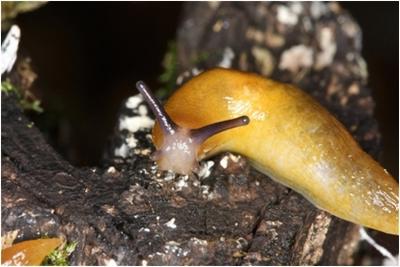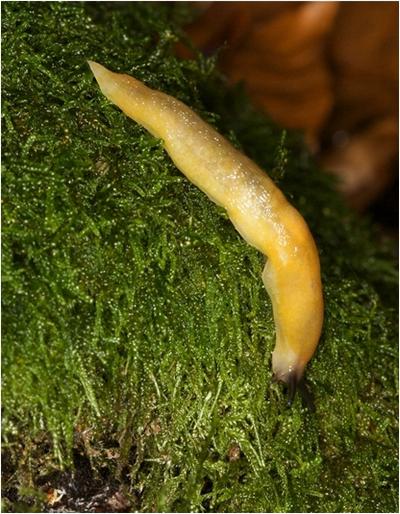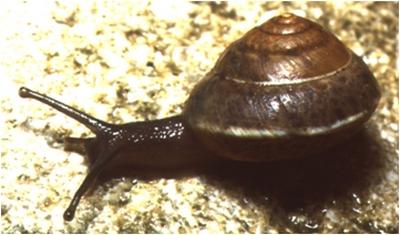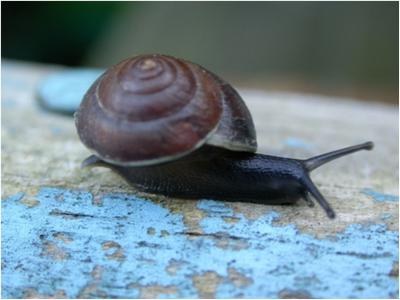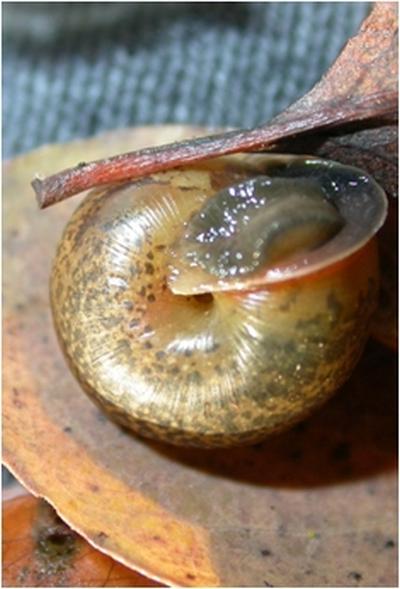Slugs
Malacolimax (Limax) tenellus
A striking yellow slug with black antennae. According to Kerney (1999) this species is restricted to ancient woodland, both deciduous and coniferous, occasionally on chalk and limestone but more commonly in old woodland on poor acid soils. Despite its lemon yellow colouration this slug is not always easy to find as it tends to hide during the day and emerge at night to feed, usually on fungi. There are few records in Worcestershire but recent searches in Wyre Forest suggest they are not uncommon in that area. It has usually been found in rather damp conditions in shaded woodland. Doubtless it exists in many other of our ancient woodlands and further records welcome. The classic wildlife photographer’s picture of this species is a yellow slug on a red fungus such as fly agaric.
The Worm slug Boettgerilla pallens commonly nicknamed Bert-the-gorilla
This slug has a wormlike extensible body 35-55mm long (Kerney 1999) adapted to life hidden beneath things or in the soil where it moves through worm burrows and similar channels. It is an introduced species from Georgia and the Caucasus first recorded in Britain 1972. It has spread widely assisted by human activities. May be found in gardens and untidy places under stones and bricks especially on moist clay soils, but it has invaded more natural areas including woodlands. We have few records. Take care examining this slug as they seem to be somewhat fragile.
In appearance this slug is very narrow and slender, almost worm-like and sharply keeled, pale greyish or with bluish hue, head and keel slightly darker, mantle pointed at its posterior end and equipped with fine concentric grooves. Sole pale yellow. Mucus colourless. Juveniles yellowish to dirty white. (http://www.animalbase.uni-goettingen.de/zooweb/servlet/AnimalBase/home/species?id=1272)
Snails
The Girdled Snail Hygromia cinctella
This is a common Mediterranean species first recorded in Britain in Devon in 1950 (Kerney1999). In subsequent years it was found in other gardens in Devon and Cornwall and in southern England. The first record for Worcestershire was reported by David Green (1998) in a Little Comberton garden: a discovery broadcast somewhat astonishingly on BBC1 TV Midlands Today! A healthy population is still present in the same garden and it has been found in other gardens throughout the county. It is probably quite widespread but with few reports to the WBRC so we should like to receive records. It is a very distinctive snail and easy to identify. David Green’s description is useful and follows:
Shell brown to very pale brown, except usually for a single thin pale (often pale yellow) band around the outer rim of the shell. The outer whorl often appears generally darker owing to blackish splodges. A careful look from different angles reveals (a hand lens is useful) that the outer rim is also strongly keeled (the rim is a pale outward ridge, not a more rounded shape like other snails in the garden). Size much smaller than the garden snail and hedge snails. Shell widest width about 10-12mm adult, but you might find a smaller juvenile. Shell height 7mm. Despite being smallish, Hygromia cinctella is quite distinctive with the rounded pyramidal shape above, the somewhat flattened whorl below the rim, and lighter coloured keel at the rim. Mouth viewed-head on is oval as a general shape, not round. Underneath, the umbilicus (hole in centre) is minute, partly covered by lip. The big pair of antennae are particularly long when fully extended.
Hygromia limbata
This is a SW European species (Kerney 1999) first discovered in Britain in Devon in 1917, and is now well-established in that area. In 1965 it was found near Little Malvern in Worcestershire. Paul Whitehead (2008) found the species in a garden in Upton-on-Severn in 1980 and 26 years later found them in the lower part of Malvern town. By chance, later in 1980, we (Brett Westwood and Harry Green personal observations) decided to look for this snail at Malvern and found many in woodlands on the hills above Little Malvern. In 2008 Brett found them again in an adjacent wood. Paul Whitehead has also reported the species from Evesham and Stanton in Gloucestershire. These observations suggest the species is spreading in the Worcestershire area. When the present authors were searching for the species near Little Malvern we noted an apparent association with ivy both on the ground and also hanging over walls. Paul Whitehead (2008) has noticed the same thing and he suggests that tangles of ivy provide a stable environment which suits this species and has also observed the snails visiting ivy flowers and eating pollen. These observation perhaps give a clue of where we should search for the species and Kerney(1999) states that it is found moist grassy places amongst herbage and ground litter on roadside banks, on overgrown ditches, quarries and gardens. The species is probably more active in poor light conditions.
This snail is somewhat globular in form and up to 15 mm in diameter. The shell is creamy white to dark brown, often with white or dark colour bands near the periphery, translucent, 5-6 weakly convex whorls with shallow suture, aperture with white lip inside, margin reflected, umbilicus very narrow, partly covered by the reflected columellar margin.
http://www.animalbase.uni-goettingen.de/zooweb/servlet/AnimalBase/home/species?id=3153
The live snails we have seen have translucent shells and often show pigment spots inside which move when the body of the snail moves in the shell. The mottling apparent in the two pictures is made by such spots and not shell pigmentation
References:
- GREEN David M 1998 New snail to Worcestershire – Hygromia cinctella.
Worcestershire Record No. 4 May 1998 p.5
- KERNEY M 1999. Atlas of the land and freshwater molluscs of Britain and
Ireland. Harley Books
- WHITEHEAD PF 2008. Observations on Hygromia limbata (Draparnaud, 1905) (Pulmonata:S Helicidae) in cereal England. Journal of Conchology 39:607-608.
